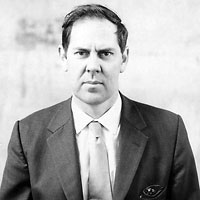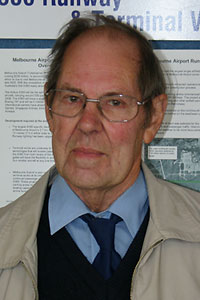
Don Whalley c.1965
(Photo: Don Whalley collection)
Donald J Whalley was born in 1929 and lived on a tobacco farm at Myrtleford, Vic, until 1942 when his father re-enlisted in the army and his mother, brother and sister moved to Wangaratta. In Wangaratta Donald studied for a Diploma of Mechanical Engineering at the local Technical School. The final year of the course was completed at Caulfield Technical School.
The State Electricity Commission (S.E.C.) employed a large percentage of graduates at the time of Don's graduation and he spent five years as an Electrical Operator on shift work at the Newport Power Station, during which he attended a course in Astronomy in preparation to building his own telescope. He also attended a series of lectures on gas turbines at the Institution of Engineers. Having no ambition to spend a lifetime on shift work he enquired from the Rolls Royce lecturer at the seminar if employment could be obtained in the United Kingdom. The lecturer obliged with a letter of introduction to the Rolls Royce Aero Division at Derby but cautioned that this letter carried no guarantee of employment.
With this document in hand Donald resigned from the S.E.C. and boarded the R. M. S. Himalaya on 11th September 1955 on her voyage to England. On arrival at Derby, he was given employment in the Weight and Material Analysis Section, with the "Vickers 1000" Conway by-pass engine as his project. After nine months he transferred to the Technical Services Branch and was involved with the performance of the Dart turbo-propeller engine. Rolls Royce chartered a train in 1956 (steam of course) to transport employees, including Donald, to and from the Farnbrough Air Show. That year the Victor, Valiant and Vulcan bombers were a highlight of the flying display.
Whilst in Derby Don attended evening courses at the Derby Polytechnic covering Gas Turbine Theory and Nuclear Physics. After about two years at Rolls Royce he returned to Australia where he obtained employment at the Aeronautical Research Laboratories in the Gas Turbine Research Group which, at that time, was developing a pulverized brown coal combustion system for a 1,000 horsepower gas turbine. Don participated in the trial runs.
Donald joined the Department of Civil Aviation Head Office "Power Plants Group" of the Airworthiness Branch in December 1960. Two years later he transferred to the Victoria-Tasmania Regional office to obtain further experience. During this period he took the opportunity to take flying lessons. In 1964 he was sent to America to visit the Pratt and Whitney Co. and Boeing Co. prior to the Boeing 727 being granted Australian certification.
From time to time Donald was seconded to the Directorate of Air Safety Investigation (DASI) to provide an Engineering input into aircraft accident investigations. In 1961 he led the Power Plant Group in the investigation of the in-flight breakup of Viscount VH-TVC during a storm at Sydney. He then provided evidence at the subsequent Board of Accident Enquiry. Following this accident DASI realized that it needed a qualified engineer on their staff and Donald was the first Professional Engineer to be appointed. He set up the nucleus of a laboratory suitable for the examination of aircraft components. The more complex examinations were sent to the Aeronautical Research Laboratories or other suitably qualified organizations to examine the problem in hand.
The following accidents have been selected as examples of his significant contribution to Aviation Safety:
- Shortly after joining the Staff of DASI he was appointed to lead the Engineering Group in the examination of an in-flight fire in Viscount VH-RMI near Winton, Queensland on 22nd November 1966. At the end of three weeks on site, the team understood what had happened to the aircraft but not the detail of why. The aircraft was crated and sent to a wool store at Footscray, Melbourne, for detailed examination and after five months a two-volume report was presented to the Minister of Civil Aviation who then announced a Board of Accident Enquiry would be convened. The findings of this investigation led to Viscount Aircraft worldwide being modified in order to prevent accidents of a similar nature.
- Donald was again appointed the leader of an Engineering Team called upon to investigate an accident involving a wing spar failure in Viscount VH-RMQ at Port Hedland in December 1968. Detailed examination and research established that a fatigue crack in the wing main spar caused the wing to separate from the aircraft. The investigation was broadened to examine spars that had been retired from other Viscount 700s and all of them were found to have small cracks similar to the crashed aircraft. This led to the need to reduce the working life of the spars in the Viscount 700 series aircraft, which effectively grounded them worldwide.
- Another investigation that Donald was involved in was that of Fokker F27 VH-EWL at Bathurst, NSW, in which the aircraft encountered a local storm on approach to the aerodrome for a night landing. The crew attempted to go-around from a very low altitude but the aircraft failed to climb despite full power being applied. The aircraft descended to ground level and came to rest in a paddock adjacent to the airport. Detailed performance calculations made from flight data recorder information and known engine and aircraft performance provided enough data for the engineering group to define the strength of the head wind, down draught and tail wind which destroyed the climb capability of the aircraft. This information was passed to the Weather Bureau for their analysis and this gave them the data-base to determine the size and intensity of a "downburst" storm. These storms had been responsible for a number of accidents on previous occasions. This was the first time worldwide that real dimensions and velocities associated with a "downburst" had been established. They have a small diameter core of high velocity down flowing air that then spills out in all directions in close proximity to the ground. The F27 had encountered such a storm at Bathurst.
Donald spent 25 years with the Department of Civil Aviation, six of which were in the Airworthiness Branch. Two were at Head Office Melbourne, two in the Victoria/Tasmania Regional Office and two more years at Tullamarine Airport. He then spent 19 years with the Bureau of Air Safety Investigation, one of which was at Canberra and at one time was the longest continuous serving officer at BASI Head Office. He investigated accidents and incidents in all states of Australia and New Guinea including one on an offshore oil rig.
Donald retired in 1987 at age 58 as a Senior Engineer/Inspector of Air Safety but retained his interest in accident investigation by doing consulting work for staff at the Melbourne BASI Office. In retirement he became involved in erecting and restoring the large diesel engines at the Melbourne Traction Engine Club at Scoresby. In latter years he has restored a 1928 Douglas Motorcycle and is pursuing his interest in model engineering.

Don Whalley, photographed at the Airways Museum on 25 July 2006.
(Photo: Phil Vabre/CAHS Collection)
Back to the main Departmental People Index
If this page does not have menu bars at top and left, click
here